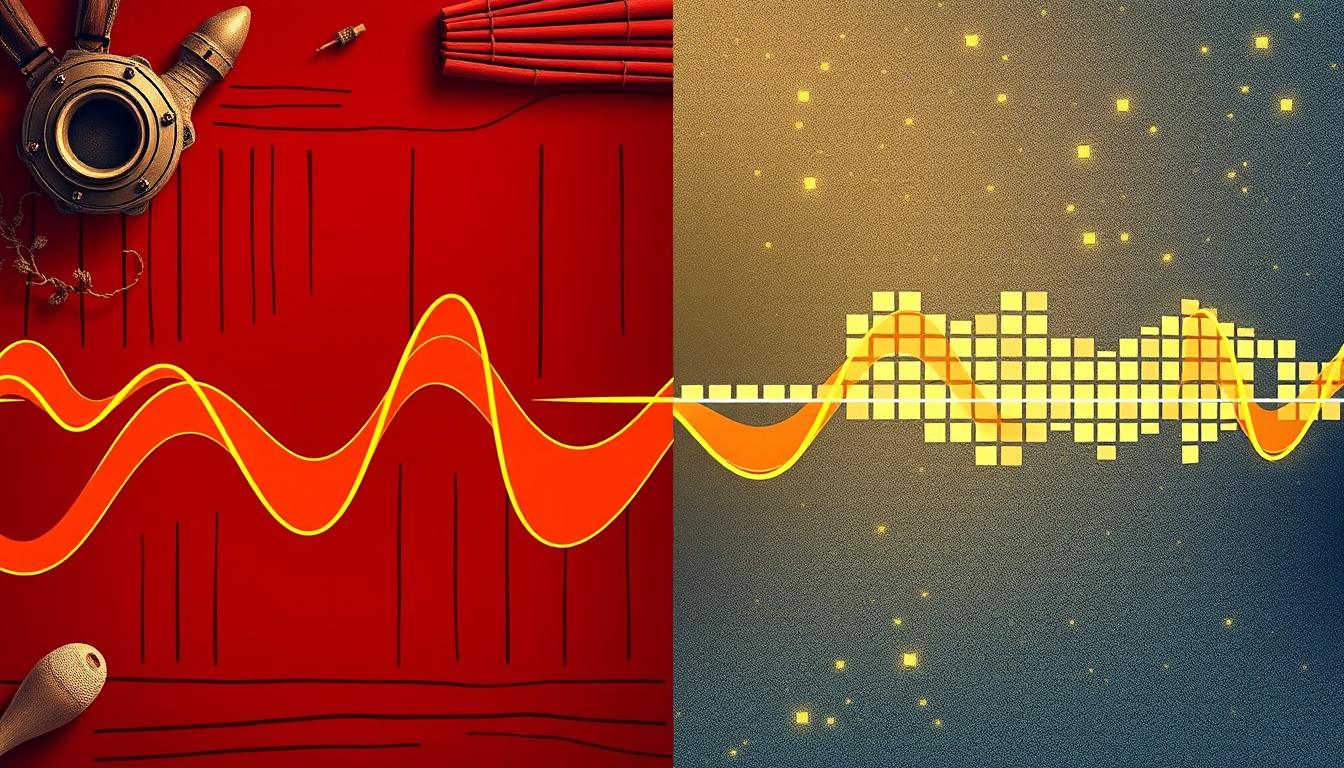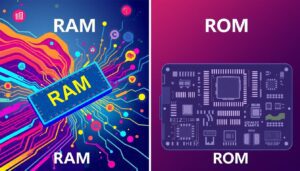Analogue vs Digital Signal. The terms analogue and digital signals are key in communication and tech. Knowing the difference between them helps us understand data flow speed and quality. Analogue signals send info continuously, while digital signals use specific values.
This article will explain how each signal type affects our daily lives. It will also prepare us for a deeper look into signal processing.
Important Lessons
- The difference between analogue and digital signals impacts communication technology.
- Analogue signals are continuous, while digital signals use discrete values.
- Signal processing is essential for both types of signals.
- Understanding signals aids in improving data transmission quality.
- Real-world applications vary significantly between analogue and digital signals.
Understanding Signals in Communication
Signals are key to communication systems, allowing us to share information. They are electrical or electromagnetic waves that carry data. Knowing about signals helps us understand communication better, especially in signal processing and the difference between analogue and digital signals.
What Are Signals?
Signals come in many forms, like audio signals for music and speech, and digital data for computers. Each type has its own role in communication. They help us send information effectively, especially in fields like telecommunications and multimedia.
Importance of Signal Integrity
Signal integrity is about the quality of the signal and keeping it accurate during transmission. It’s crucial for both analogue and digital signals. Factors like environmental noise and signal degradation can harm it. To keep signal integrity high, we use strict signal processing and infrastructure, essential for reliable communication.
Key Characteristics of Analogue Signals
Understanding analogue signals is key to seeing their importance. They have a continuous waveform, showing an endless range of values. This is different from digital signals, which only show a few values.
Continuous Waveform Nature
Analogue signals change smoothly over time, making a continuous wave. This lets them capture the details of sound, light, and more. They are great for audio and video because they offer high fidelity and detail.
Examples of Analogue Signal Applications
Analogue signals are still important today. They are used in many areas, including:
- Traditional radio broadcasts: Uses frequency modulation to send audio over long distances.
- Vinyl records: Records sound on a physical medium, giving a unique audio experience.
- Temperature sensors: Produce a continuous output voltage that matches temperature changes.
Analogue signals are still vital today, even with digital technology growing. They fill gaps where digital can’t meet the needs.

Features of Digital Signals
Digital signals have unique features that set them apart from analogue signals. They use discrete values, making data representation and manipulation more efficient. This understanding sheds light on technology advancements and the importance of digital signal processing.
Discrete Values and Signal Sampling
Data is symbolized by binary code, it is made of digital signals with 0s and 1s. This allows for precise signal sampling. Continuous analogue signals are turned into digital formats by measuring them at set intervals.
This process reduces noise and distortion. It makes digital transmissions clearer and more reliable than analogue vs digital signal communications.
Digital Signal Processing Overview
Processing of digital signals improves or excerpts details from digital signals. It’s used in telecommunications, processing of audio, and multimedia creation. DSP’s versatility lets engineers improve signal quality and perform data compression.
These methods demonstrate how digital signals are more productive and more transparent than analogue signals.

Analogue vs Digital Signal: Important Distinctions
The truth is essential to recognize the way analog and digital signals different from each other. We look at their modulation techniques and how they handle signal noise. These factors are crucial for the quality and effectiveness of communication systems.
Signal Modulation Techniques
Modulation is vital for delivering both analogue and digital signals. Analogue signals employ techniques such as:
- Modulation of Amplitude (AM): Modifies the amplitude of the carrier wave.
- Modifies the frequency of the wave of carriers by frequency modulation.
Conversely, digital signals employ a variety of techniques, including:
- Phase-Shift Keying: Modifications the stage of the signal to communicate data.
- Change in Frequency Keying: transmits symbols using different frequencies.
Every technique offers advantages for certain applications. This affects the signal’s quality and reliability.
Impact of Signal Noise and Distortion
Both digital and analog signals are affected by signal noise. Analog transmissions are more likely to be distorted and interfered with. The waveform can be altered by even tiny noise levels, which lowers the quality of the signal.
Digital signals, however, are more resistant to signal noise. Their use of discrete values helps them better separate the intended information from background noise. This leads to better reception and accuracy in data transmission.
Conversion Techniques: Analogue to Digital
Turning analogue signals into digital formats is a key process. It involves several important steps. These steps are crucial for the quality of the digital output.
Sampling is the first step. It captures the analogue signal at set intervals. The sampling frequency is key to accurately represent the signal digitally.
After sampling, quantization happens. It maps the sampled values to a limited range. This creates a digital version of the signal.
Encoding is the final step. It changes the quantized values into a binary format. This format is what digital systems can understand.
Each step affects the signal’s quality during the conversion. A bad conversion can cause loss of detail, noise, or distortion. This can harm performance in digital applications.
Analog-to-digital converter (ADC) innovations are essential. They improve accuracy and speed. This makes it possible to reproduce analogue inputs with high fidelity.
With these advancements, digital signal processing becomes more advanced. It allows for better manipulation and transmission of data. Knowing these techniques is essential for working with signals in digital environments.
Real-World Applications of Different Signal Types
Knowing how analogue and digital signals work helps us see their strengths and weaknesses. They are used in many ways, like in broadcasting and data transmission. Each type has its own role in sharing information.
Use Cases in Broadcasting
In broadcasting, both analogue and digital signals are key. Analogue has been used for radio and TV for a long time. It uses continuous waveforms for audio and video.
Classic FM and AM radio use analogue for music and talk shows. This gives them a warm sound. Digital broadcasting, however, uses new tech to send info more efficiently. It offers better sound and video, and more channels in the same space.
Analogue vs Digital in Data Transmission
In data networks, analogue signals face big challenges. They get noisy and lose quality over long distances. Digital signals, on the other hand, keep their quality and clarity, even with disruptions.
Digital signals have big advantages in data transmission:
- They use bandwidth better, so data moves faster.
- They have better ways to find and fix errors, making them more reliable.
- They grow and change with new tech, supporting progress.
The table below shows the main differences between analogue and digital signals in broadcasting and data transmission:
| Feature | Analogue Signal | Digital Signal |
|---|---|---|
| Quality | Subject to noise and distortion | High quality, maintained throughout transmission |
| Bandwidth Utilization | Limited channels in a frequency band | Multiple channels with efficient bandwidth usage |
| Flexibility | Less adaptable to new technologies | Easily scalable and compatible with modern systems |
| Signal Processing | Basic filtering | Advanced digital signal processing techniques |
Choosing between analogue and digital signals affects our daily communication. It shows how important it is to know about these technologies.
Final Thought
Analogue vs Digital Signal. Looking into the differences between analogue and digital signals shows us their unique traits and uses. Analogue signals, with their smooth waveforms, can capture the details of real-life events. But, they can also pick up noise and get distorted.
Digital signals, on the other hand, are made up of clear, separate values. This makes them perfect for today’s communication needs. They are key in keeping our digital messages clear and strong.
The move towards digital signal processing is clear. It’s making our digital communications clearer and more reliable. Knowing about these basics is key, especially as we use more digital tech in our lives.
As we move into a more digital world, both analogue and digital signals are still important. Understanding their differences helps us see their role in today’s communication. It also encourages us to keep exploring new tech that will shape our future.
FAQ
What is the primary distinction between digital and analog signals?
An endless number of values can be present in continuous analog transmissions. Conversely, digital signals employ discrete values, such as 0s and 1s.
How does signal integrity affect communication systems?
Signal integrity is about the quality and purity of a signal. It’s key for clear data transmission. Poor signal integrity can cause distortion and loss of information.
What are some common applications of analogue signals?
Analogue signals are used in old radio broadcasts, vinyl records, and temperature sensors. They’re still important in many modern technologies, even with digital formats.
What does digital signal processing (DSP) involve?
DSP is about improving or extracting information from digital signals. It includes filtering and compression. It’s used in telecommunications, audio, and multimedia.
What are signal modulation techniques?
Modulation techniques encode information onto a carrier wave. For analogue, AM and FM are common. Digital signals use PSK and FSK.
How do noise and distortion impact signals?
Noise and distortion can harm both analogue and digital signals. But digital signals are more resistant. This makes digital communication clearer and more reliable.
How does simple to-computerized transformation function?
Simple signs are switched over completely to computerized ones through the course of simple to-advanced change. It involves sampling, quantization, and encoding. This is crucial for keeping signal quality in digital systems.
How are analogue and digital signals used in broadcasting?
Analogue signals were used for old radio and TV. Now, digital signals are used for modern broadcasting. Digital offers better quality and uses bandwidth more efficiently.
Why are different signal types important in data transmission?
The choice between analogue and digital signals affects efficiency and reliability. Knowing the differences helps pick the right signal type for networking and communication.






